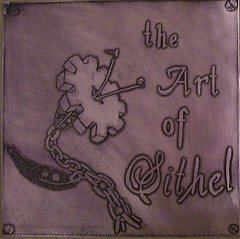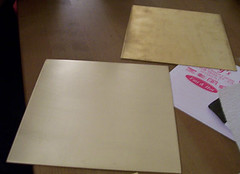Date : Some time in February 2007
Materials : Acid [type?], sharpie marker, sand paper, brass square, rubbing alcohol, baking soda
Tools : plastic tub, chop sticks, rubber gloves
Finished Product:

Currently a paper clip is taped to the back of it so it may hang in my cube.
Process:
You take a chunk of etch-able metal (brass and copper were the only options I was made aware of) and you sand it clean. Perhaps a dash of rubbing alcohol, the point is to make it smooth and clean so that there are no rogue spots when you etch. Now you mark up that bit o' metal with a "resist"- in my case a very fine brand name Sharpie marker did the trick. What you cover will not be etched, obviously. The trick I found was wrapping my mind around "lines" which would be neither etched or un-etched, but rather level changes. You see this in the chain links and definition of the gear. Leaving gaps or drawing thin lines were the best methods of definition, rather then settling only on broad silhouetted. Be careful with pencils, I found they left faint marks, working as very weak half-assed resists.


Now you've drawn on it, drop it in a tub of acid. The acid should be in a plastic or glass tub and safety measures such as rubber gloves and glasses wouldn't hurt. Keep some baking powder (baking soda?) on hand to neutralize the acid. Let it sit for a while, jostling it occasionally (we used chopsticks). Be mindful that a buildup will probably form if you let it sit absolutely still, leading to a sort of odd tightly drawn saranwrap look at the edges of resist. Time of sitting may varry, I believe we were using 15-30 minutes. Remove and coat liberally with baking powder to neutralize acid. Scrub, powder, water, scrub, you get the idea.
From this point, personal preference kicks in. I found I liked the look of cleaning it via rubbing alcohol, re-coating the ENTIRE thing with Sharpie, then sanding lightly the surface. This highlights the edges and lets the un-etched segments pop out more. If you don't like the look, you can always re-clean via rubbing alcohol.

Thoughts : Given my short-notice need to come up with an etch-able idea, I found the gear flower adaption worked very well. The font and my grammar are lacking, but when are they not? The gear surface is by far the best aspect of the piece, while the riveted leaf failed to come out clearly. I found the screw heads in the corners added that much needed final touch. If only one corner wasn't bent...
The subject of the gear-flower is only tangentially related to my (fictionalized) Gaslight universe:
The earliest strains were firs breed by Master Lilly Fletcher in the year 1871. There has been much speculation in the community and across the guilds as to how she first coaxed that metallic gear from the flower bud- rusty fertilizer, the grafting of a pocket watch, and brute force magic all candidates depending on who you ask. Though she was known to keep company with several prestigious Physic & Sorcererous guild members, Master Fletcher never offered co-authorship credit to anyone for her work and none tried to take it.
The first varieties which produced wooden gears are not recognized as being especially note worthy- displaying nothing more then excessive topiary skill and being of little use due to structural integrity for actual work. It was only with the revelation of possible uses- and the clear financial benefit- of the farmed gears that the plant was hailed for the marvel that it is.

1 comment:
I always love the look of those things just after they come out of the acid (and are, um, rinsed free of the acid, which I'm not so fond of). Nice worn steampunked look.
Post a Comment